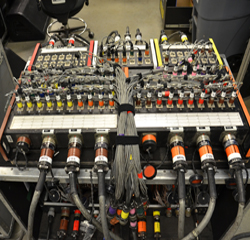
Rat observes that recording seems to fall into two categories.
The first is an isolated split recording where the signals go to a recording truck, or in the case of the Red Hot Chili Peppers, to a console located in a remote room in the venue that is fed from a separate A/D rack stage-side and mixed there. This mix might go to broadcast or another application.
The second is that the FOH or monitor console sends a recording feed, taking the mic outputs in their raw form to a multitrack recorder.
Greg Snyder of Thunder Audio (Livonia, MI) also confirms that even though many of the latest mixing consoles can share a stage rack and digitally split the signal, his team often opts not to share mic preamps and to use an analog split. He finds that off-the-shelf splitters can be very reliable, and that “with today’s digital consoles, we find that passive splitters are very easy to use as go-to packages.”
Snyder adds that quite often the FOH engineer will create a mix to be embedded with video, which is transported from the console to the video truck via an analog snake or fiber interface. He notes that mixing for both live and video “requires that the engineer be very conscious of the mix they’re providing so that it will be usable for broadcast.”
Hall Of Fame & More
When I caught up with him recently, Mark Dittmar, the live broadcast events engineer at Firehouse Productions (Red Hook, NY), had just returned from the Rock & Roll Hall of Fame show, which he’s worked for several years running. This year’s event combined a live show for about an audience of about 15,000, plus broadcast, at Brooklyn’s Barclay Center arena.
In addition to Firehouse’s live audio setup that included infrastructure, splits and comms, All Mobile Video provided the television truck and a Music Mix Mobile truck did the audio mixing. Firehouse handles overall coordination of the show, and then, Ditmar notes, “informs the others how we’re handing things off to them.”
Both 3-way and 6-way splitters were deployed to route audio signals to the various stage racks, and then to mixing consoles in the venue and out to the trucks. “We always split everything analog; we don’t do any digital sharing,” he explains. “That has a major negative impact on the speed and workflow that we’re doing. We keep everything analog in the split world, and then it goes digital from that point on out. With how fast changes come at us in this type of show, it’s proven to be impractical for any type of preamp sharing.”
He also points out that the FOH music and production desks, monitor desk, music mix desk, and broadcast desk are usually different makes/models, and there’s typically only one song during rehearsal to set levels and EQ, along with a quick camera check, and then it’s on to the next act.
Firehouse utilizes modified Whirlwind splitters, with Dittmar noting that “one of the cornerstones of our company is having absolutely zero split issues.” It’s not uncommon to see a 192-input show split six ways, so the company uses a very specific grounding scheme and is “militant” about sticking to it.
Part of the splitter’s design is focused on enforcing proper grounding, and the tech crew also follows a rigid power distribution scheme that also reinforces best practices in grounding. Dittmar concluded our conversation by stressing the basics: “Splitting and grounding is something where you can be 99.9 percent correct, and the 0.1 percent that you’re wrong about brings everything down.”
Grounded In Analog?
While digital networking has matured greatly over the past several years and can effectively distribute audio signals to multiple sources reliably, there are still some areas within the audio chain where old-school analog devices remain a standard. Signal splitting and isolation seems to be one of those areas.
In part, this is a practical decision driven by the nature of shows being set up in different venues every night while accommodating the rapid changes between acts and the desire of engineers to have full control over the inputs into their consoles. There also seems to be some resistance to surrendering that control, based on prior experiences with earlier networking technology and anecdotes from fellow engineers.
The bottom line is that analog splitting is a proven solution for sharing live audio. It will take more time, positive experiences and perhaps technical development before digital splitting becomes more commonplace in live sound.
Gary Parks is a writer who has worked in pro audio for more than 25 years, holding marketing and management positions with several leading manufacturers.
